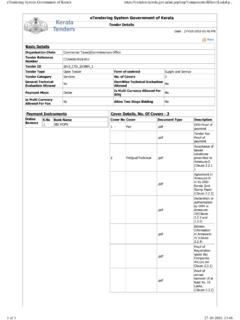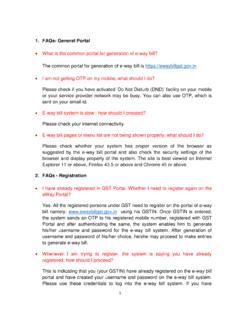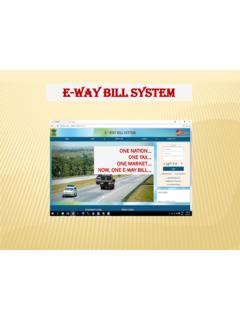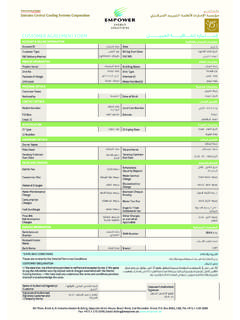Transcription of E-Way Bill System - keralataxes.gov.in
1 E-Way Bill System User Manual 2018 National Informatics Centre New Delhi E-Way Bill System User Manual Release Date: 26/03/18, Version: Page 2 No part of this document shall be reproduced without prior permission of National Informatics Centre, New Delhi. E-Way Bill System User Manual Release Date: 26/03/18, Version: Page 3 Table of Contents Table of Contents .. 3 List of Abbreviations .. 4 1. Introduction .. 5 2. E-Way Bill System .. 6 3. Registering and Enrolling for E-Way Bill Systems .. 10 4. Opening the E-Way Bill System .
2 17 5. Options under E-Way Bill .. 19 6. Managing Consolidated E-Way 32 7. Rejecting E-Way Bills .. 38 8. Generating Reports .. 39 9. My Masters .. 42 10. User Management .. 46 11. Registration .. 50 12. 54 13. Grievance .. 57 14. Best Practices to follow .. 59 E-Way Bill System User Manual Release Date: 26/03/18, Version: Page 4 List of Abbreviations Abbreviation Full Form API Application Program Interface CGST Central Goods and Service Tax CKD Completely Knocked Down EBN E-Way bill Number EWB E-Way bill GSP Goods and Services Tax Suvidha Provider GST Goods and Services Tax GSTIN Goods and Services Tax Identification No GSTN Goods and Services Tax Network GSTR-1 Goods and Services Tax Form -1 HSN Harmonized System of Nomenclature ICT Information and Communication Technology IGST Integrated Goods and Services Tax IT Information Technology MIS Management Information System NIC National Informatics Centre OTP One Time Password PAN Permanent Account Number QR Quick Response RFID Radio-Frequency identification Device SGST State Goods and Services Tax SKD Semi Knocked Down SMS Short Message Service URL Uniform Resource Locator VAT Value added Tax
3 E-Way Bill System User Manual Release Date: 26/03/18, Version: Page 5 1. Introduction Background Introduction of Goods and Services Tax (GST) across India with effect from 1st of July 2017 is a very significant step in the field of indirect tax reforms in India. For quick and easy movement of goods across India without any hindrance, all the check posts across the country are abolished. The GST System provides a provision of E-Way Bill, a document to be carried by the person in charge of conveyance, generated electronically from the common portal. To implement the E-Way Bill System , ICT based solution is required. Hence, as approved by the Goods and Services Tax (GST) Council, a web based solution has been designed and developed by National Informatics Centre and it is being rolled out for the use of taxpayers and transporters.
4 Purpose and Intended Audience This document aims to explain the operational procedure on how to use web based E-Way Bill System . It also explains the features of E-Way Bill System and role of the stakeholders involved in the System . This document is intended for registered taxpayers under GST and un-registered transporters, who are the main stakeholders of E-Way Bill System under GST. Scope The scope of this document covers: Explaining the features of the E-Way Bill System . Activities of various stake holders. Registering and enrolling for the E-Way Bill System . Processes involved in generation of web based E-Way Bill. Enabling the various modes of the E-Way Bill generation. Managing the sub-users by the stake holders. URL or Web site address E-Way Bill System User Manual Release Date: 26/03/18, Version: Page 6 2.
5 E-Way Bill System Waybill under Earlier VAT System In order to monitor the bulk trade which necessarily takes place through trucks, it was mandated under VAT that each such consignment shall be accompanied by a Delivery Note which were issued from the VAT offices to the taxpayers. At the end of every month the taxpayer had to submit an utilisation statement of the forms issued. The intention of the tax office was that to control the tax evasion being done by few of the tax payers. The taxpayer also used to face a great deal of hardship while seeking the blank Delivery Notes as he/she would have to make several visits to the tax office. At check-posts the trucks, would get detained for a long time on frivolous grounds. Thus, it was a lose-lose situation for the trade as well as the government. In order to overcome these challenges, a new idea/ System was introduced.
6 In the new System , the taxpayer could upload the details of each transaction to the departmental Server through the internet, and once uploaded the Server would automatically generate a Delivery Note with a unique number, then this unique number could accompany the goods vehicle as a proof of having uploaded the transaction. Such a System would by itself ensure that once the Delivery Note is issued there could be no possibility of tax evasion. It was one of the most successful and efficient System of prevention of tax evasion on one hand and an e-Governance initiative that provided the speedy and efficient services to the taxpayers on the other hand. This System was introduced and used by number of states. E-Way Bill System under GST Unique Selling Proposition (USP) of Goods and Services Tax is One Nation- One Tax One Market. Introducing a separate way bill for each State under the GST System would definitely complicate the compliance and in turn affect the business of the taxpayers and transporters.
7 Such a System of separate E-Way Bill for each State would result in hindrance of movement of goods and free trade from one State to another. The State and Central Government officers will also find it difficult to cross-verify such E-Way Bills if generated independently by each State. A new process is thus required which would ensure that a taxpayer, prior to movement of goods via a conveyance , would inform each transaction s details to the tax department, obtain an acknowledgement number for having thus informed, and then use this acknowledgement number as a valid document accompanying the truck. The idea is that the taxpayer be made to upload the details of each transaction to a common portal through the Internet, and once uploaded, the common portal would automatically generate a document which can be tracked and verified easily by any stakeholder.
8 E-Way Bill System User Manual Release Date: 26/03/18, Version: Page 7 E-Way Bill in GST Rule Information to be furnished by every registered person prior to commencement of the movement of goods and generation of E-Way Bill. Upon generation of the E-Way Bill on the common portal, a unique E-Way Bill number (EBN) shall be made available to the supplier, the recipient and the transporter on the common portal. The person in charge of a conveyance shall carry (a) the invoice or bill of supply or delivery challan, as the case may be; and (b) a copy of the E-Way Bill or the E-Way Bill number. The details of E-Way Bill generated shall be made available to the recipient, if registered, on the common portal, who shall communicate his acceptance or rejection of the consignment covered by the E-Way Bill.
9 The information furnished while generating E-Way Bill such as 1) GSTIN of recipient, 2) Place of delivery, 3) Invoice Number, 4) invoice date, 5) Value of goods, 6) HSN code, etc. shall be made available to the registered supplier on the common portal who may utilize the same for furnishing details in FORM GSTR-1. An officer authorised by the State can intercept any conveyance to verify the E-Way Bill or the E-Way Bill number in physical form for all inter-State and intra-State movement of goods. A summary report of every inspection of goods in transit shall be recorded online by the proper officer in specified format within twenty four hours of inspection and the final report in specified format shall be recorded within three days of the inspection. Where a vehicle has been intercepted and detained for a period exceeding thirty minutes, the transporter may upload the said information in a specified format on the common portal.
10 Objectives Single E-Way Bill for movement of the goods throughout the country. To prevent the evasion of tax. Hassle free movement of goods across India. Tracking the movement of goods with E-Way Bill number. Easier verification of the E-Way Bill by officers. E-Way Bill System User Manual Release Date: 26/03/18, Version: Page 8 Stakeholders The objective behind introducing E-Way Bill is to effectively address the expectations and concerns of the stakeholders by leveraging the use of ICT. The following are four key stakeholders of the E-Way Bill: Suppliers Generate the E-Way Bills and reject the E-Way Bills generated by other party against his/her name, if it does not belong to him/her. Recipients - Generate the E-Way Bills and reject the E-Way Bills generated by other party against his/her name, if it does not belong to him/her.









